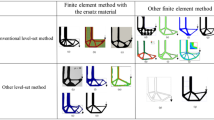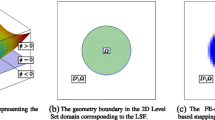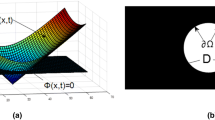Abstract
This paper focuses on the stress-constrained topology optimization of minimizing the structural volume and compliance. A new method based on adaptive volume constraint and stress penalty is proposed. According to this method, the stress-constrained volume and compliance minimization topology optimization problem is transformed into two simple and related problems: a stress-penalty-based compliance minimization problem and a volume-decision problem. In the former problem, stress penalty is conducted and used to control the local stress level of the structure. To solve this problem, the parametric level set method with the compactly supported radial basis functions is adopted. Meanwhile, an adaptive adjusting scheme of the stress penalty factor is used to improve the control of the local stress level. To solve the volume-decision problem, a combination scheme of the interval search and local search is proposed. Numerical examples are used to test the proposed method. Results show the lightweight design, which meets the stress constraint and whose compliance is simultaneously optimized, can be obtained by the proposed method.

























Similar content being viewed by others
References
Allaire G, Jouve F, Toader AM (2004) Structural optimization using sensitivity analysis and a level-set method. J Comput Phys 194:363–393
Bendsøe MP (1995) Optimization of structural topology, shape and material. Springer, Berlin Heidelberg
Bendsøe MP, Sigmund O (2003) Topology optimization: theory, methods and applications, 2nd edn. Springer, Berlin
Bruggi M (2008) On an alternative approach to stress constraints relaxation in topology optimization. Struct Multidiscip Optim 36:125–141
Bruggi M, Venini P (2008) A mixed FEM approach to stress-constrained topology optimization. Int J Numer Methods Eng 73:1693–1714
Cheng GD, Guo X (1997) ε-Relaxed approach in structural topology optimization. Struct Optim 13:258–266
Choi KK, Kim NH (2005) Structural sensitivity analysis and optimization. Springer, New York
Collet M, Bruggi M, Duysinx P (2016) Topology optimization for minimum weight with compliance and simplified nominal stress constraints for fatigue resistance. Struct Multidiscip Optim 55:1–17
De Leon DM, Alexandersen J, Fonseca JSO, Sigmund O (2015) Stress-constrained topology optimization for compliant mechanism design. Struct Multidiscip Optim 52:929–943
Deaton JD, Grandhi RV (2014) A survey of structural and multidisciplinary continuum topology optimization: post 2000. Struct Multidiscip Optim 49:1–38
Duysinx P, Bendsøe MP (1998) Topology optimization of continuum structures with local stress constraints. Int J Numer Methods Eng 43:1453–1478
Duysinx P, Sigmund O (1998) New developments in handling stress constraints in optimal material distribution. In: Proceedings of the 7th AIAA/USAF/NASA/ISSMO symposium on multidisciplinary analysis and optimization, St. Louis, Missouri 1501–1509
Guilherme CEM, Fonseca JSO (2007) Topology optimization of continuum structures with epsilon-relaxed stress constraints. In: Alves M, da Costa Mattos H (eds) International symposium on solid mechanics, mechanics of solids in Brazil, vol 1. Brazilian Society of Mechanical Sciences in Engineering 239–250
Guo X, Zhang WS, Wang MY, Wei P (2011) Stress-related topology optimization via level set approach. Comput Methods Appl Mech Eng 200:3439–3452
Guo X, Zhang W, Zhong W (2014) Stress-related topology optimization of continuum structures involving multi-phase materials. Comput Methods Appl Mech Eng 268:632–655
Guo X, Zhang W, Zhang J, Yuan J (2016) Explicit structural topology optimization based on moving morphable components (MMC) with curved skeletons. Comput Methods Appl Mech Eng 310:711–748
Haug EJ, Choi KK, Komkov V (1986) Design sensitivity analysis of structural systems. Academic Press, London
Holmberg E, Torstenfelt B, Klarbring A (2013) Stress constrained topology optimization. Struct Multidiscip Optim 48:33–47
Jeong SH, Yoon GH, Takezawa A, Choi DH (2014) Development of a novel phase-field method for local stress-based shape and topology optimization. Comput Struct 132:84–98
Jr Emmendoerfer H, Fancello EA (2014) A level set approach for topology optimization with local stress constraints. Int J Numer Methods Eng 99:129–156
Kaw AK, Kalu EE, Duc N (2011) Numerical Methods with Applications. University of South Florida, Textbooks Collection 11. http://scholarcommons.usf.edu/oa_textbooks/11
Kiyono CY, Vatanabe SL, Silva ECN, Reddy JN (2016) A new multi- p-norm, formulation approach for stress-based topology optimization design. Compos Struct 156:10–19
Lee K, Ahn K, Yoo J (2016) A novel P-norm correction method for lightweight topology optimization under maximum stress constraints. Comput Struct 171:18–30
Lin CY, Sheu FM (2009) Adaptive volume constraint algorithm for stress limit-based topology optimization. Comput Aided Des 41:685–694
Liu Z, Korvink JG (2008) Adaptive moving mesh level set method for structure topology optimization. Eng Optim 40:529–558
Lopes CG, Novotny AA (2016) Topology design of compliant mechanisms with stress constraints based on the topological derivative concept. Struct Multidiscip Optim 54:737–746
Luo Z, Tong L, Wang MY, Wang S (2007) Shape and topology optimization of compliant mechanisms using a parameterization level set method. J Comput Phys 227:680–705
Luo Z, Wang MY, Wang S, Wei P (2008) A level set-based parameterization method for structural shape and topology optimization. Int J Numer Methods Eng 76:1–26
Luo Y, Wang MY, Kang Z (2013) An enhanced aggregation method for topology optimization with local stress constraints. Comput Methods Appl Mech Eng 254:31–41
París J, Navarrina F, Colominas I, Casteleiro M (2010) Block aggregation of stress constraints in topology optimization of structures. Adv Eng Softw 41:433–441
Pedersen P (2000) On optimal shapes in materials and structures. Struct Multidiscip Optim 19:169–182
Pereira JT, Fancello EA, Barcellos CS (2004) Topology optimization of continuum structures with material failure constraints. Struct Multidiscip Optim 26:50–66
Qiu GY, Li XS (2010) A note on the derivation of global stress constraints. Struct Multidiscip Optim 40:625–628
Rong JH, Xiao TT, Yu LH, Rong XP, Xie YJ (2016) Continuum structural topological optimizations with stress constraints based on an active constraint technique. Int J Numer Methods Eng 108:326–360
Sigmund O (2001) A 99 line topology optimization code written in Matlab. Struct Multidiscip Optim 21:120–127
Silva GAD, Cardoso EL (2017) Stress-based topology optimization of continuum structures under uncertainties. Comput Methods Appl Mech Eng 313:647–672
Verbart A, Langelaar M, Keulen FV (2016) Damage approach: a new method for topology optimization with local stress constraints. Struct Multidiscip Optim 53:1081–1098
Wang MY, Wang X (2004) PDE-driven level sets, shape sensitivity and curvature flow for structural topology optimization. Comput Model Eng Sci 6:373–395
Wang MY, Wang X, Guo D (2003) A level set method for structural topology optimization. Comput Methods Appl Mech Eng 192:227–246
Wang Y, Luo Z, Kang Z, Zhang N (2015) A multi-material level set-based topology and shape optimization method. Comput Methods Appl Mech Eng 283:1570–1586
Wendland H (1995) Piecewise polynomial, positive definite and compactly supported radial functions of minimal degree. Adv Comput Math 4:389–396
Xia Q, Shi T, Liu S, Wang MY (2012) A level set solution to the stress-based structural shape and topology optimization. Comput Struct 90–91:55–64
Yang RJ, Chen CJ (1996) Stress-based topology optimization. Struct Multidiscip Optim 12:98–105
Yoon GH (2014) Stress-based topology optimization method for steady-state fluid–structure interaction problems. Comput Methods Appl Mech Eng 278:499–523
Zhang W, Yuan J, Zhang J, Guo X (2015) A new topology optimization approach based on moving Morphable components (MMC) and the ersatz material model. Struct Multidiscip Optim 53:1243–1260
Funding
This research was supported by the National Basic Scientific Research Program of China [grant number JCKY2016110C012]; and the National Natural Science Foundation of China [grant numbers 51675196 51421062].
Author information
Authors and Affiliations
Corresponding author
Rights and permissions
About this article
Cite this article
Chu, S., Gao, L., Xiao, M. et al. A new method based on adaptive volume constraint and stress penalty for stress-constrained topology optimization. Struct Multidisc Optim 57, 1163–1185 (2018). https://doi.org/10.1007/s00158-017-1803-4
Received:
Revised:
Accepted:
Published:
Issue Date:
DOI: https://doi.org/10.1007/s00158-017-1803-4




